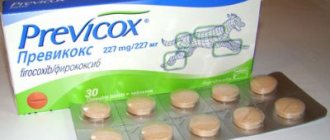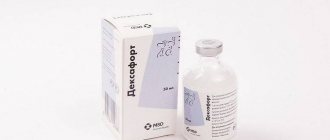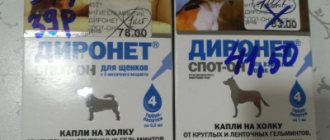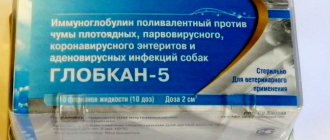Is it possible if you are vomiting?
The essence of the drug's action is to block receptors to the vomiting center of the medulla oblongata from the pylorus of the stomach. The active ingredient, metoclopramide, increases the tone of the smooth muscles of the stomach and prevents the appearance of involuntary gag reflexes.
Dogs are prescribed to normalize conditions related to gastric and intestinal motility, as well as before X-ray examinations. The drug is used in case of nausea and vomiting caused by oral viral infection, injury, medication, liver or kidney dysfunction.
Restrictions
You should not give the medicine more than 3 times a day, and in case of severe vomiting, it is better to administer an injection solution: the dog may regurgitate the tablet, and the treatment will be ineffective. If symptoms persist within a week, you should contact your veterinarian to change the medication.
It is forbidden to use Cerucal:
- pregnant and lactating females;
- puppies under 8 months of age;
- animals with liver and kidney pathologies;
- if you suspect gastric bleeding, intestinal perforation;
- those suffering from asthma;
- with convulsions.
Taking the medicine may cause side effects:
- allergic reactions;
- drowsiness and lethargy;
- decreased appetite;
- anxiety.
Instructions for use
Dosage in ampoules
Solution for injection 0.5% is packaged in ampoules of 2 ml. For dogs, the dosage is very small and amounts to 0.5-0.7 mg per 10 kg of weight. The maximum daily dosage of metoclopramide should not exceed 1-2 mg/10 kg of weight.
Where to give the injection?
Cerucal injections are administered intravenously, intramuscularly and subcutaneously.
How to inject intramuscularly?
For intramuscular injection, it is necessary to determine the point on the outer side of the thigh, in the most massive place. By manually examining, make sure that a large layer of muscles is concentrated in the intended location and there is no thinning.
The needle should penetrate the skin and subcutaneous fat layer, to a depth of about 1-1.5 cm for medium and large dogs. If the dog is small or the muscles are thin, there is a chance of puncturing the muscle right through, which is extremely painful for the dog.
The needle is inserted at an angle of 90 degrees, with a sharp movement. Cerucal must be poured in smoothly, at medium speed. With the same clear movement, we pull out the needle and lightly massage the insertion site.
Intravenous injection
When administering subcutaneously, it is necessary to lift the skin at the withers with one hand, forming a fold. With the other hand, insert the needle, puncturing the skin and subcutaneous layer, approximately 2 cm (for medium and large dogs). After administration of the medicine, a small spherical compaction may form, which will go away on its own within 3-4 hours.
Intravenous administration requires advanced medical skills and should be carried out in a hospital setting by a veterinarian.
How many tablets should I use?
The dosage of the active substance in one tablet is 10 mg. The required one-time volume, as well as for injections, is 0.3-0.5 mg per 10 kg of dog. Thus, the correct dosage can be calculated for dogs weighing 40 kg (1/4 tablet) and above.
How to give them?
Cerucal in tablets is given in a forced form: the medicine is placed on the root of the tongue, while the mouth is closed and held closed for some time. To provoke the swallowing reflex, apply the palm with light pressure from top to bottom along the throat. Cerucal should be given 30 minutes before feeding the dog.
Important! You should not give Cerucal tablets during repeated vomiting. Part of the active substance will inevitably be removed from the body through vomit. It will be very difficult to determine how much the dog ultimately received.
Is a veterinarian's appointment required?
No specialist will say that you can give even the most harmless medicine without the prior advice of a professional. "Cerucal" for dogs poses a certain danger, since there are many contraindications and side effects may occur. It is difficult to calculate the dosage if there is no accurate information about the pet’s weight or a diagnosis has not been made.
If your dog starts vomiting, you need to invite a veterinarian to your home. He will examine the animal, make a preliminary diagnosis and send it for examination. If it is not possible to call a doctor, then you need to take your four-legged friend to the clinic yourself. So that the road goes smoothly, the dog does not spoil the upholstery of the car and feels comfortable, you can give a minimum dose of “Cerucal”, or even better, use the completely harmless “Smecta”.
Comparison of release forms
- Cerucal in injections begins to act 3 minutes after intravenous administration and after 10-15 minutes intramuscularly. This method is effective in cases of uncontrollable vomiting, or when taking pills causes rejection by the dog’s body. In liquid form, the dosage of the drug is easier to calculate for small dogs.
- Cerucal in tablets is more convenient to use for preparing an x-ray examination, with a single vomiting and the urge to vomit.
In both forms of release, the duration of administration should not exceed seven days.
Storage conditions for the medicine
The drug does not contain particularly “delicate” components, but, nevertheless, when storing it, the following storage conditions must be observed:
- The storage location must be protected from direct sunlight. This is especially important when storing the liquid dosage form of the drug. Ultraviolet radiation has a detrimental effect on the components of the drug.
- When storing the tablet form of the drug, the temperature should be maintained in the range from 0° to 25°C. It is advisable to store the medicine in the form of a solution at a temperature from 0° to 4°C (the ideal place is the top shelves of a household refrigerator). Freezing is extremely undesirable, but the manufacturer reports that after thawing, the product fully retains all its therapeutic properties.
- The medicine is stored so that it is guaranteed that children and pets do not have access to it.
Poisoning
When conducting laboratory studies, it was established that the use of Cerucal at a dose ten times higher than the therapeutic dose, the following deviations were observed in dogs:
- decreased appetite and amount of food consumed;
- as a result, loss of body weight;
- anorexia;
- diarrhea;
- anemia;
- pronounced sedative effect.
A twofold increase led to an exacerbation of existing chronic gastrointestinal diseases, nervousness appeared, and, in some cases, aggression.
An absolutely lethal dosage is 300 mg/kg of dog weight.
Side effects
In case of an overdose or individual sensitivity of the animal’s body (and this happens infrequently), the following side effects are possible:
- Problems with stool. The dog may suffer from both diarrhea and severe, prolonged constipation.
- In some cases, muscle spasms are observed.
- The dog becomes restless and nervous, barking often and for no reason.
- Swelling is possible, especially pronounced in the area of the chest, paws and groin area.
- Hives and other allergic reactions.
- Tachycardia, the dog's pulse increases sharply.
- Increased blood pressure. If the dog already suffers from hypertension, this is extremely dangerous and can lead not only to a serious hypertensive crisis, but also to kidney damage.
If the “side effects” do not appear too clearly, then the drug should be stopped, and after a while the pet’s condition will return to normal. In other situations, the medication is also immediately stopped and a veterinarian is called.
Pregnant, lactating and puppies
The drug is contraindicated in puppies under 8 months of age. For young dogs, it is necessary to calculate the dosage extremely accurately.
The medicine is contraindicated during pregnancy, up to 35 days. Nausea and vomiting during this period are natural. In case of exacerbation of chronic diseases accompanied by vomiting, take the drug only under strict veterinary supervision.
And only in the case when the lack of stabilization of the mother’s condition outweighs the risk of possible harm to the fetus.
When feeding, it is necessary to avoid taking the drug, as it has high permeability. In large dosages it will pass through breast milk to puppies. Side effects from the drug during the breastfeeding period can be fatal for them.
Components included in the drug
The drug contains the following compounds:
- In the production of tablets, purified starch is also used, which serves as the main molding component.
- Lactose (milk sugar).
- Gelatin used as a binder.
- Silicon compounds and magnesium stearate.
- The injection form of the drug also contains disodium sulfite and edetate, as well as additionally purified water for injection.
- Sodium chloride (regular table salt).
Metoclopramide hydrochloride monohydrate is the main active compound to which the medicine owes its effect. This substance has a pronounced antiemetic effect. It was originally used medicinally to treat migraines. At the same time, doctors noticed that patients taking this medicine did not vomit at all, even in cases where it should have developed. The essence of the action is to accelerate the removal of food from the stomach to the intestines. Does not cause diarrhea.
Owner reviews
- “After visiting the exhibition, the dog fell ill with a oral viral infection. There was repeated diarrhea and vomiting. The doctor prescribed Cerucal in injections and gradually we managed to restore a normal state.”
- “My dog was constantly sick and vomited in the car, now I give her half the dosage in tablets before the trip and travel goes smoothly!”
- “I personally saw the death of 5 puppies at the age of 1 month after using Cerucal! The owners, without a doctor, injected them themselves and apparently made a mistake with the dosage. We couldn't save anyone."
How does Cerucal work on a dog?
Effect of Cerucal on a dog:
- The drug improves the tone of the muscles of the lower parts of the stomach, including its sphincter, as well as the tone of the muscles of the small intestine.
- The drug reduces the activity of the muscle tissue of the esophagus.
- Due to improved peristalsis of the lower stomach and intestines, the movement of semi-digested food through the gastrointestinal tract is accelerated.
- Normalization of bile secretion. The drug improves the tone and contractility of both the gallbladder itself and the bile ducts of the liver. The product also relieves spasm of the exit sections of the ducts in the lumen of the duodenum.
- The medicine completely stops or significantly reduces the frequency of hiccups.
- The drug helps fight stomach cramps that occur against the background of hyperacid gastritis.
Although the drug is capable of normalizing digestive processes, it does not directly affect the process of synthesis of digestive enzymes and juices. This makes it relatively safe for dogs, but it should still only be prescribed and dosed by a veterinarian!
Cerucal is a very active drug. After administration, it begins to be absorbed into the blood almost immediately. The maximum therapeutic concentration is achieved in just an hour. The medicine is effective for 12 hours. But to achieve maximum effect in the shortest possible time, it is recommended to use a liquid dosage form. Thus, after intramuscular administration of the drug, the effect of the latter begins in just 15 minutes, and after intravenous administration of the drug, the effect occurs within three minutes.
Contraindications
Cerucal (injections) is often used to stop vomiting in a child under two years of age, although this is prohibited. Tablets are used similarly for children under 14 years of age, usually also to get rid of vomiting.
Many mothers share information with each other about how they gave the drug to their child, advising them not to pay attention to the contraindications in the instructions, since nothing happened to their baby. Of course, no one wants anything bad when advising each other, but this is completely incorrect from a medical point of view.
It is strictly forbidden to use Cerucal for the following diseases and pathological conditions:
- Hypersensitivity to the active component or the drug in general.
- Lactose/galactose intolerance.
- Glaucoma.
- Intestinal obstruction.
- Arterial hypotension/hypertension.
- Gastrointestinal bleeding.
- First trimester of pregnancy (in the 2nd and 3rd trimester, use is allowed only for vital indications).
- Lactation.
- History of epilepsy, Parkinson's disease.
Before taking the drug, it is recommended that you read the full list of contraindications, which is presented in the official instructions.
Diagnostic features
A condition in which there are disturbances in the functioning of the excretory system is rarely determined by external signs - the symptoms can suggest or suspect the disease. This is also explained by the fact that the symptoms are “masked” as other diseases, which are excluded only with the help of additional research methods.
An accurate diagnosis of renal failure is made only based on the results of a comprehensive examination with the obligatory implementation of:
- examination and collection of a detailed medical history (medical history and lifestyle);
- laboratory tests of urine and blood;
- Ultrasound of the kidneys and abdominal organs;
- fluoroscopy of the kidneys.
The diagnosis of chronic renal failure is made ONLY after laboratory tests of blood and urine.
When analyzing urine it is noted:
- increased protein levels (proteinuria);
- the presence of leukocytes and erythrocytes;
- presence of sediment;
- decrease in its density (isosthenuria);
- pH shift to the acidic side.
Blood chemistry:
- increased urea;
- increase in creatinine level;
- fluctuations in the amount of protein in either direction;
- decreased potassium levels;
- increase in the level of calcium, magnesium and phosphorus (with chronic renal failure);
- increased sodium levels.
General blood analysis:
- decrease in hematocrit values;
- decreased hemoglobin levels;
- increase in the number of leukocytes;
- drop in platelet and lymphocyte levels.
Differentiation of acute renal failure and chronic renal failure:
- in case of acute renal failure, anemia does not have time to develop due to the transience of movement, in case of chronic renal failure it is clearly expressed;
- CRF begins smoothly and lasts a long time; at the time of diagnosis, the prognosis is most often unfavorable; AKI manifests suddenly with a lightning-fast course, the prognosis is favorable with timely diagnosis and proper treatment;
- when palpating the kidneys in chronic renal failure, they are almost always painless, while in acute renal failure the pain syndrome is clearly expressed;
- in case of acute renal failure the clinic is bright, in case of chronic renal failure it is not or is very blurred.
Breed exceptions
There are no breed restrictions for the drug, however, if used on dogs of the Toy group, there is a high probability of overdose of the drug due to the high concentration of the active substance.
annotation
Cerucal (in Latin - Cerucal) is a drug that most have not only heard of, but is also used by many for vomiting and nausea. It is prescribed by most doctors as an antiemetic and choleretic agent.
The drug is also actively used in veterinary medicine for dogs and cats after taking medications or before x-ray examinations.
The release form is presented in tablets or solution for injection.
Pharmacological group - medications used for problems of the gastrointestinal tract (gastrointestinal tract) - antiemetic.
Special instructions
When being treated with this medication, a person needs to stop driving a car and operating complex equipment, as this requires increased attention. At any moment the person may become dizzy or feel lethargic.
You should not drink alcohol, as there is a high probability of negative effects.
Children in adolescence are more vulnerable to increased side effects than adult patients, so the drug must be used under strict medical supervision.
For patients who suffer from serious kidney and liver diseases, accompanied by changes in organ function, the dosage is set specifically for the patient.
Children under the age of two cannot use Cerucal, since there is no confirmed data on its effect on the baby’s body.
Cerucal
The active ingredient of the drug Cerucal is metoclopramide. It is able to block nerve receptors that transmit impulses from the duodenum and stomach to the vomiting center. Metoclopamide improves the tone of the gastric and intestinal muscles and has a positive effect on the secretion of bile. The drug begins to act 10-15 minutes after use.
In addition to metoclopamide, the tablet form of Cerucal includes:
- gelatin;
- starch;
- magnesium stearate;
- lactose monohydrate;
- silica.
In addition to the main active ingredient, the liquid form of Cerucal contains:
- sodium chloride;
- sodium sulfite;
- sterile aqueous solution;
- edetate disodium.
Ampoules have a volume of 2 ml. Tablets are packaged in blisters and then in cardboard boxes of 50 pcs.
The use of Cerucal for cats is possible for the following diseases:
- lack of stomach tone;
- intestinal hypotension;
- reflux esophagitis;
- dyscresia of the bile excretory pathways;
- stomach ulcer;
- hiccups;
- flatulence;
- duodenal ulcer;
- vomit;
- nausea.
© shutterstock
Cerucal can also be prescribed to cats or dogs that need to enhance intestinal motility. The drug can be used during the rehabilitation period after surgery. Cerucal will be effective even if the cat’s vomiting is associated with traumatic injuries.
The product can only be used after consultation with a veterinarian, as it is not compatible with all medications. Sometimes Cerucal is used before radiography of the gastrointestinal tract in animals. Its use in research is due to its antiemetic effect. The drug also enhances peristalsis, which is sometimes necessary during radiography.
Is it possible for cats to have Cerucal if the animal’s vomiting has psychogenic factors? It is undesirable, since its use will not give the desired effect, so it is better to prescribe other drugs.
Chronic renal failure
Impaired kidney function in this form of the course develops for a very long time and is due to the fact that this organ is gradually deprived of its excretory functions. Nephrons (structural kidney units) are replaced by connective tissue, scars form, the kidney shrinks and loses its working abilities. Often found in older animals.
Veterinarians practically distinguish the following main stages of renal failure:
- Latent (hidden). This is a period when the functioning of the kidneys is already impaired, but the pathology does not manifest itself in any way. It is possible to identify some deviations in the analyzes, but they are rarely done, because there is no clear indication for this.
- Initial. This period lasts up to several months and is accompanied by vague symptoms that are usually not attributed to the kidneys. Blood counts indicate obvious pathology.
- Conservative. Most often, the diagnosis of chronic renal failure is made precisely during this period - the history of the disease and life, direct examination and indicators of nitrogen and creatinine in the blood give every reason for this.
- Terminal. Deviations in the functioning of some other organs begin to appear, the levels of creatinine and urea in the blood go off scale. The animal will die without hemodialysis or surgery.
At stages 3 and 4, the diagnosis is easiest to make, however, this is already a reason for a cautious and unfavorable prognosis. Symptoms of chronic renal failure begin to appear when the kidneys are damaged to at least 65-70% (sometimes up to 80%).
Probable Causes
- metabolic pathologies (diabetes mellitus, amyloidosis - a disorder of protein metabolism in the body);
- tumor process in the kidneys;
- conversion from acute renal failure;
- against the background of chronic pancreatitis (inflammation of the pancreas);
- urolithiasis of the kidneys;
- any chronic kidney disease associated with viruses or bacteria (pyelonephritis);
- congenitally underdeveloped kidneys and their structures;
- renal polycystic disease (limited cavities with fluid form throughout the “body” of the kidney. Persian cats are most often affected).
With all the variety of causes that provoke chronic renal failure, it is practically impossible to find out exactly due to the profound degeneration of the renal structures at the time of diagnosis
How does it manifest?
The degree of manifestation of symptoms directly depends on the degree of kidney damage at the time of detection of abnormalities.
What owners see:
- the cat stopped eating completely;
- depressed and lethargic, sleeping most of the time;
- the animal is clearly losing weight, the costal arches begin to appear and the stomach begins to fall in;
- almost constant drooling, nausea (manifested by constant licking of the lips and nose), periodic vomiting not associated with food or water intake;
- perversion of taste preferences - the cat may begin to eat inedible objects (for example, toilet filler granules);
- the animal often begins to go to the toilet (up to 6-8 times a day), and the amount of urine may increase or decrease;
- increased nervous excitability, inadequate reactions to loud sounds (the cat gets scared even when called loudly - it twitches, presses itself to the floor or runs away);
- constipation appears, bowel movements are observed every few days;
- at the terminal stage, confusion, twitching of individual parts of the body or paws (tics), convulsions, and coma may be noted.
What does the vet see?
- extensive swelling starting from the paws and moving to the chest and abdomen;
- slow heart rate (bradycardia);
- blood pressure jumps up (hypertension);
- the coat is dull, brittle, cannot be laid evenly, with areas of alopecia;
- noticeable softening of the facial bones when palpated (due to a lack of calcium and excess phosphorus);
- pallor of the mucous membranes in the mouth;
- stomatitis with ulcerations on the tip of the cat's tongue (an important clinical sign);
- the kidneys can be easily felt and a change in their size in any direction (enlargement or shrinkage) is detected.
What do the tests show?
- obvious anemia;
- the level of creatinine and glucose in the blood rises;
- Sugar and protein are detected in the urine, and its specific gravity decreases.
- Ultrasound: changes in the contours of the kidneys (often becoming uneven when wrinkled);
- change in size (usually decrease, but can also increase).
When is Cerucalh2 used?
1Use of the substance Omeprazole Orally, intravenously. Adult patients: duodenal ulcer; prevention of relapse of duodenal ulcer; stomach ulcer; prevention of recurrence of stomach ulcers; erosive and ulcerative lesions of the stomach and duodenum associated with Helicobacter pylori (as part of complex therapy); erosive and ulcerative lesions of the stomach and duodenum associated with taking NSAIDs; prevention of erosive and ulcerative lesions of the stomach and duodenum associated with taking NSAIDs, prevention of stress ulcers; reflux esophagitis; long-term monitoring of patients with cured reflux esophagitis; gastroesophageal reflux disease; Zollinger-Ellison syndrome. Application in pediatrics. Inside. Children over 2 years old with body weight ≥20 kg: reflux esophagitis; gastroesophageal reflux disease (heartburn and sour belching). Children and adolescents over 4 years of age: duodenal ulcer associated with Helicobacter pylori (as part of complex therapy).
> Analogues of Cerucal
Analogs: Metoclopromide.











